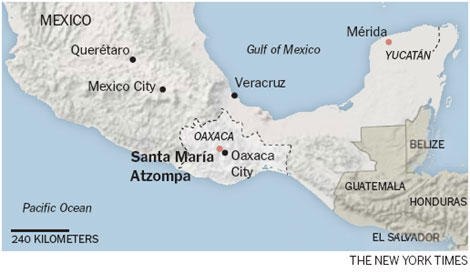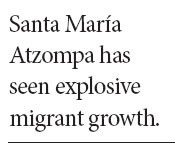Latin migration is shifting to the south
Updated: 2012-01-15 08:08
By Damien Cave(The New York Times)
|
|||||||

Santa Maria Atzompa, Mexico

Throughout Mexico and much of Latin America, the old migratory patterns are changing. Instead of heading for the United States, the mobile and restless are now casting themselves across a wider range of cities and countries in the region, pitting old residents against new, increasing pressure to create jobs and prompting nations to rewrite their immigration laws, sometimes to encourage the trend.
"Before all these people came, everything was tranquil," said Marcelino Juarez, 61, an artisan at the local ceramics market in this precolonial village outside Oaxaca City that has seen an influx of new arrivals. "They bring complications. They don't bring benefits."
The United States is simply not the magnet it once was. Arrests at the United States' southwest border in 2011 fell to their lowest level since 1972, confirming that illegal immigration, especially from Mexico, has reached what experts now describe as either a significant pause or the end of an era.
But this is not a shift in volume as much as direction. Nearly two million more Mexicans lived away from their hometowns in 2010 than was the case a decade earlier, according to the Mexican census. Experts say departures have also held steady or increased over the past few years in Guatemala, El Salvador, Peru and other Latin American countries that have traditionally been hubs of emigration.
The migrants are just not always going where they used to.
Mexicans, for example, are increasingly avoiding the United States and the border region, as well as their own capital, and are moving toward smaller, safer cities like Merida, Oaxaca City and Queretaro. Experts say more Guatemalans are also settling in Mexico after years of passing through on the journey north.
To the south, the pull of Chile, Argentina and Brazil is also strengthening. The International Organization for Migration reports that the Bolivian population in Argentina has increased by 48 percent since 2001 (to 345,000), and that the country's Paraguayan and Peruvian populations have grown even faster.
From the papayas grown by Bolivians in Argentina to the recent discovery of exploited illegal workers in Chile and conflicts over local government in southern Mexico, this intraregional migration in Latin America has become both a challenge and a promising surprise.
"It's like a river changing course," said Gabino Cue Monteagudo, the governor of Oaxaca. "It's the process of development - it's inevitable."
In Santa Maria Atzompa, where thousands of mostly poor, rural families have chosen to settle, the growth has been "fast, barbaric and anarchic," said Jorge Hernandez-Diaz, a sociologist in Oaxaca.
In 1990, the population was 5,781. Around 2006, opportunities in America fell away and the dangers and cost of crossing the border became prohibitive amid drug violence and increased border security. Now, more than 27,000 people live in Atzompa, according to the 2010 census, with more coming.
Other regional poles are experiencing similar growth.

Mexico's coastal and exurban areas have expanded partly because of the government's efforts to decentralize development, often with incentives for international businesses. In December, Nissan said it would build a factory in Aguascalientes. In Oaxaca State, experts say, the migration out of rural areas is also a product of land reforms in 1992 that, along with the North American Free Trade Agreement, made it harder for farmers to eke out a living and easier for them to sell land.
In South America, too, free trade agreements have contributed to more regional movement, as have steadily growing economies and new laws favoring migrants in Argentina, Uruguay, Mexico and Ecuador, among others. Improvements in technology (especially access to cellphones) and infrastructure have also made it easier to discover and reach jobs in new places.
"It's the economics, but also the culture and more information," said Juan Artola, South America director for the International Organization for Migration.
Migrants are now making Latin America more integrated, and more metropolitan, say demographers. About 77 percent of all Mexicans now live in urban areas, up from 66 percent in 1980. That makes it easier and cheaper to provide services.
For migrants, education seems to be the main draw. Gabriel Hernandez, 21, said that four of his brothers moved here to study. The family opened a bodega about a year ago.
Many of the new residents in Atzompa say they are happy with how things have gone.
Javier Espiritu 36, who recently opened a carpentry shop, said business is decent, but his reasons go beyond economics. He came here with his wife and two children, a rarity for migrants who cross into the United States illegally, separated from their families. He said he traveled home to his village six hours away twice a year.
"When my mom needs anything, she calls me," he said. "Can you imagine me trying to take my whole family" to the United States?
And yet, new residents bring new challenges. Poverty in Atzompa remains high. A drug rehabilitation center has been built; strip clubs are nearby, and longtime residents now complain about having too many young men around with different values in their midst.
Atzompa seems to have reached its breaking point. Only a handful of its roads are paved, and the main secondary school, built for about 120 students, now has nearly 700. The strains have led to a deep conflict over government and culture.
Once Atzompa was simply a rural village run according to the communal "usos y costumbres" system of government, where full civic rights accrued only to people who participated in government or community service and were born there. But as new residents began to outnumber old ones over the past few years, the recent arrivals complained they were paying taxes and getting few or no services in return.
Last year, the community hit an impasse. When the municipal president's term ended, a state administrator took over. Now the state legislature must decide whether to keep "usos y costumbres" or establish the kind of party system found in most of Mexico. Meanwhile construction workers say increased competition has decreased their daily rate to $11, from $14 five years ago, while prices for empty lots have doubled to about $7,200.
Many of Mexico's young people are betting that more education will land them better jobs at home. But for now, said David Fitzgerald, a demographer, "their aspirations are higher than their opportunities."
Whether Mexico closes that gap may determine if its new graduates once again head north. "That's our great challenge," Governor Cue said.
The New York Times
(China Daily 01/15/2012 page9)